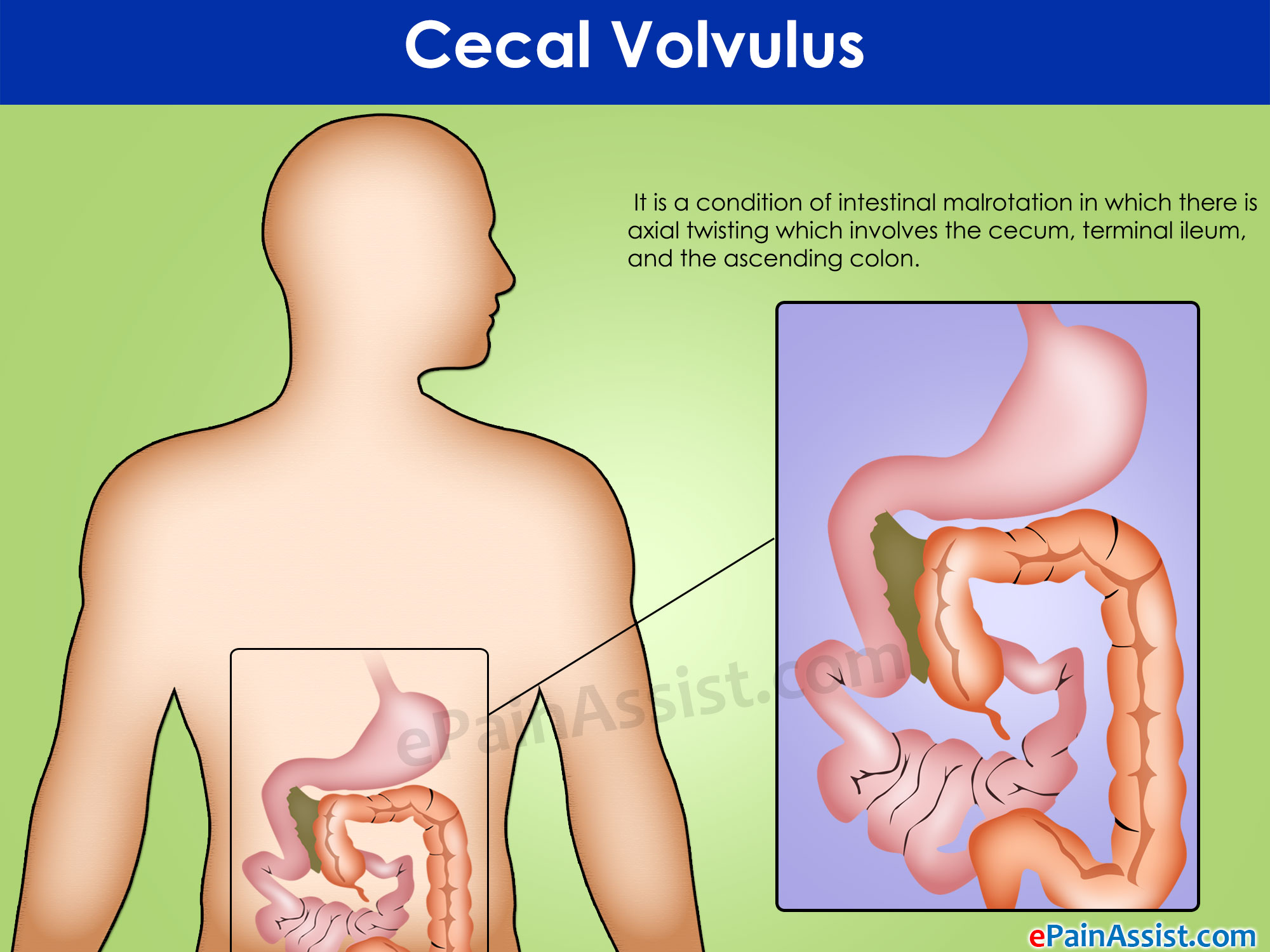What Is Cecal Volvulus?
Cecal Volvulus is a condition of intestinal malrotation in which there is axial twisting which involves the cecum, terminal ileum, and the ascending colon. Cecal Bascule is another variant of Cecal Volvulus and is associated with upward and anterior folding of ascending colon and this variant is responsible for about 10% of cases of cecal volvulus. Even though Cecal Volvulus and Cecal Bascule are two separate entities but they have many similar features to include intestinal obstruction and strangulation. Studies suggest that about 5% of all intestinal obstructions in adults are caused by Cecal Volvulus. The age at which the symptoms present themselves vary greatly depending on the intestinal motility which is different for people coming from different ethnic backgrounds and geographical locations.
What Are The Causes Of Cecal Volvulus?
The development of intestine during the development of the fetus is perhaps the most complex part of the development of the entire fetus. During the final stages of development of the digestive tract, the cecum rotates in an anticlockwise direction from left side of abdomen to its anatomical position in the right lower abdomen. Simultaneously, the right colon mesentery gets fixated to the retroperitoneal structures. Children who do not have complete intestinal rotation tend to have inadequate fixation of the right colon which raises the potential for Cecal Volvulus.
What Are The Symptoms Of Cecal Volvulus?
Some of the symptoms of Volvulus are:
- Dark tarry stools
- Severe constipation
- Abdominal distention
- Abdominal pain
- Nausea
- Vomiting
- Shock.
Some of the symptoms of Cecal Volvulus may be so severe that the child may have to be taken to the emergency room for treatment.
How Is Cecal Volvulus Diagnosed?
Since majority of people with Cecal Volvulus present with pictures which point to an intestinal obstruction, hence radiographic studies of the abdomen are used for identifying the obstruction. In most of the cases, the radiographic studies are able to pinpoint abnormalities which virtually confirm the presence of Cecal Volvulus.
What Are The Treatments For Cecal Volvulus?
The treatment for Cecal Volvulus is surgery to correct the malrotation. The surgical options to correct the obstruction are manual detorsion, cecopexy, cecostomy, and colectomy either by open or by laparoscopic methods. As this condition is quite unusual, there are no treatment trials to help guide treatment management decisions in patients. It is the general opinion that if any gangrenous changes and perforations are observed while doing surgery that these structures are excised, although the extent of operative procedure in patients where none of these complications are found remains unknown. There has been however debates among those surgeons who are in favor of resecting the colon and those who are not in favor of it. The surgeons who are in favor of the procedure cite the reasons for favoring the resection as chances of the volvulus recurring and other complications associated with cecostomy and cecopexy.
The surgeons who are not in favor of excision cite their reasons as reduced mortality and low recurrence rates. Even if resection of ascending colon almost completely nullifies the chances of a volvulus recurrence, the procedure takes too much time and the chances of a physiological insult is also more in patients undergoing this procedure. Studies suggest that operative mortality with colectomy is higher than mortalities associated with cecopexy and cecostomy, although the conflicting factor in outcomes reported by these procedures is that colon resection is absolutely required in cases where there is bowel strangulation.
Diet For Cecal Volvulus
Yes, there are certain dietary modifications which can be done pre and post treatment for individual affected with Cecal Volvulus. Some of the dietary modifications are as mentioned below:
- The affected individual will need to eat more small meals instead of one large meal in a day so that the digestive system is not under pressure to digest large amounts of food at one time and also provide the body with adequate nutrition.
- In cases of Cecal Volvulus, especially postsurgery, it is recommended that the individual if possible stay away from foods rich in fiber like apples, nuts, broccoli, and instead try and consume a bland diet. It is also recommended to stay away from spicy or fried foods as it is difficult to digest and it may also slow down the healing process.
- Avoiding constipation is also necessary in Cecal Volvulus and constipation may occur especially if there is reduced fiber intake. Thus, it is recommended that the individual consume plenty of water to avoid constipation.
- In case if an individual is diagnosed with Cecal Volvulus, it is recommended to take care of the diet as Cecal Volvulus even after being treated has a tendency to recur. Since some of the intestine is removed during surgery for Volvulus the body finds it difficult to absorb vital minerals and vitamins; therefore, it becomes necessary for the individual to be on electrolyte replacement so that the body does not get devoid of any vital electrolytes or minerals.
- Raffensperger, J. G. (1975). Cecal volvulus. World Journal of Surgery, 25(1), 122-126. https://link.springer.com/article/10.1007/BF01550948
- Perry, C. P., & Thompson, W. M. (1992). Cecal volvulus: a frequently missed diagnosis. American Journal of Roentgenology, 158(4), 763-765. https://www.ajronline.org/doi/abs/10.2214/ajr.158.4.1546602
- Sakellaridis, T., Kalogeropoulos, G., Giafas, I., Anagnostou, D., & Koulas, S. (2009). Incarcerated cecal volvulus: a rare entity difficult to differentiate from sigmoid volvulus. The World Journal of Gastroenterology, 15(40), 5064. https://www.ncbi.nlm.nih.gov/pmc/articles/PMC2761645/
- Ashurst, J., & Wasson, D. (2019). Cecal volvulus. https://www.ncbi.nlm.nih.gov/books/NBK470267/
- MedicalNewsToday. (2021). What to know about cecal volvulus. https://www.medicalnewstoday.com/articles/326489
- InTechOpen. (2019). Cecal volvulus. https://www.intechopen.com/chapters/67132
- American Society of Colon and Rectal Surgeons. (2021). Volvulus. https://www.fascrs.org/patients/disease-condition/volvulus
- University of Michigan Medicine. (2021). High Fiber Diet. https://www.uofmhealth.org/health-library/tp11381
Also Read:

